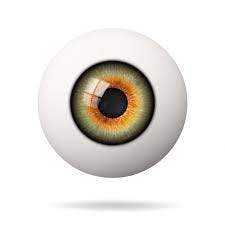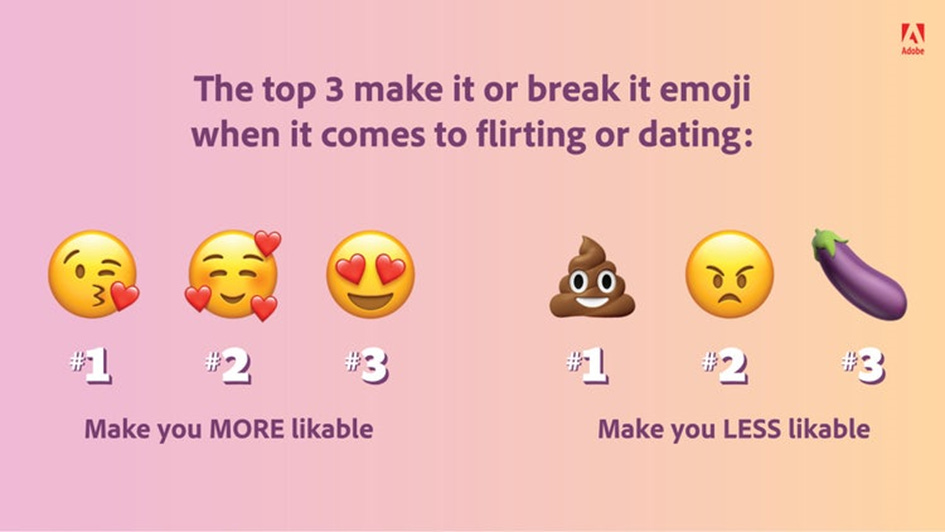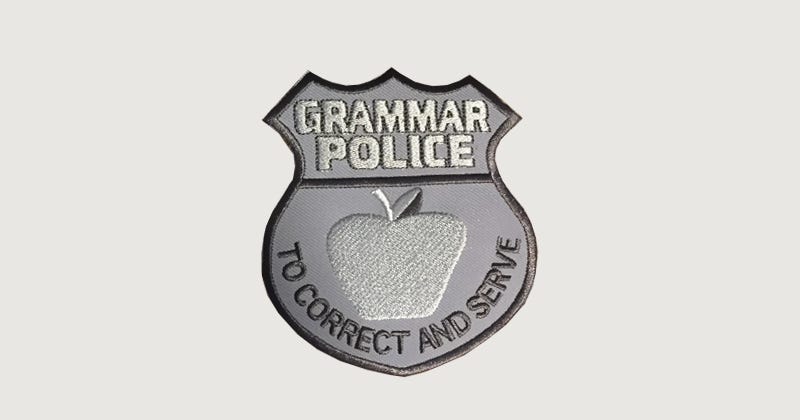14 February. You’re either excited (presents from your lover!) or depressed (no presents, no lover). If you’re happily partnered, you can stop reading right here. Well, not really. Maintenance, maintenance! And good to know the rules of the game out there, just in case… A well-placed emoji or exclamation mark and correct grammar can make your online dating profile stick out among the thousands and hundreds of thousands (millions!) floating around the digital ether. They can get you an answer, a date, even a relationship – even sex! I mean, if that’s not reason enough to perk up! Here are five ultimate ways of improving your text-flirting through punctuation on this Valentine’s Day.
Okay, first things first: emojis are punctuation. I know, I know, it’s not intuitive. Hear me out.
Punctuation – from an expansive point of view – is any glyph (a fancy word for “sign”) that orders text, that separates it, sections it out. Sometimes such glyphs point out grammatical or syntactical relationships like your usual full stop, comma, or question mark. Sometimes, glyphs offer a comment of sorts on the preceding words, for example hashtags #self-referential. Sometimes glyphs make us do something to the text, literally: we rove around with our eyes, flip through the book or scroll through the document. An asterisk * or footnote has us go on a wild-goose chase for proof and pointers at the bottom of the page, back of the book, or even the library (I’m a Millennial, okay? Google for you, Gen Z).
Punctuation marks also encode feeling into a silent sober text. Some more than others. Exclamation marks very obviously express joy, frustration, anger, and enthusiasm. But have you ever felt anxious at receiving a one-word-text followed by a full stop? Are they upset with me??? See, even the seemingly most neutral sign can evoke strong feelings in the right context.
¶
According to this capacious definition, emojis certainly belong to punctuation: they create boundaries between words or sentences, they offer hashtag-like comments, and they encode feeling in text. Emojis deserve more (much more) space than this, and we’re now only interested in their role in dating and relationship management. As such, emojis and other kinds of punctuation are really doing an enormous amount of social work for us: writing is a tricky business at the best of times, and a cause for total disaster at the worst. It’s disembodied, that means we don’t have our voice to modulate the tone of the words we’re saying (writing); we don’t have body posture, facial expressions, hand movements, gaze, breathing, the co-regulation of two bodies sharing the same space. We don’t have any of that when we send written words out as ambassadors for us, hoping for the best. Misunderstanding abounds.
The internet is the ultimate world of disembodiment: it’s not only that the ordinary problems of (mis)communication persist; we also struggle with the lack of material evidence for the other person’s existence. Paper - that’s something the writer held in their hands before sending it to us readers. There might be folds. There might be scratchings-out, underlinings, blotches. Handwriting. In the virtual world, there’s none of that. We’re really reduced to just an electronic impulse. Zeros and ones and zeros again.
So, it’s no surprise at all that we try hard to control how someone might interpret our naked string of words that’s so emptied out of any trait or evidence of “us”. It makes perfect sense we should hang onto emojis for dear life, to recruit them for our desperate need to communicate. It’s also clear emojis should powerfully impact digital spheres where the main purpose is to present oneself and meet people. Such as online dating.
¶
A 2021 analysis by a Tinder user of her data showed that 57% of all first messages following a match remain unanswered. That’s more than half! 😳 Perhaps a disheartening justification for the flack levelled at Tinder whose rationale seems to be based on a numbers game: swiping right with as many people as possible as intuitively as possible (that is, whether you respond to the pictures or not), rather than discerning who you’d realistically like to meet. Depending on the few pictures and even fewer information the app allows its users on their profiles. Not exactly a promising avenue for the most important decision of your life.
Whatever the reasons for those unanswered calls for mating are, the bottomline is clear: you have to stick out. Online dating is a cold cold unforgiving world, punishing any mistake or oversight with indifference and ghosting, particularly at the beginning. So, profiles and first messages are crucial. Eyeballs eyeballs eyeballs, people! Attention is the currency of the 21st century.
While the algorithms mixing our profiles like card-games are murky and unfair (who shuffles us? How? Why?), we do get to have some kind of say over our self-representation and communication. And finally, drumroll, here they come…the 5 ultimate how-tos to get yourself that sweetheart today! 💘💘💘
¶
#1 USE EMOJIS! But wisely and sparingly…
I cooked up a little survey on my Twitter account, and the results don’t surprise.
Emojis are what you make them. Adobe conducted an extensive review in 2022 published as The Future of Creativity trend report, asking 5000 Americans how emojis impacted their life (very much, it turns out). Emojis are everywhere and can positively influence debates around inclusivity and equality of gender, ethnicity, or sexuality, because we have emoji-people with all kinds of ages, (dis)abilities, skin tones, and sexual orientations. The study found participants felt more connected to emoji users than writers who were not using any. They saw emoji-ists as friendlier, warmer, funnier, and cooler (yay! 🙏🏼). More than half of participants were more likely to respond to someone who uses emojis. And the good thing is, the most frequently texted emojis (in general, not just a dating context) were pretty simple straightforward ones:
1) 😂 2) 👍🏼 3) ❤️ 4) 🤣 5) 😢
It seems that we might not actually be interested in the huge number of highly complex pictures: those five here, they’re just what old-school emoticons expressed: :-) and :-( happy, sad. That’s all.
So, when creating a dating app profile, or texting a potential date, do use emojis. But not too many, not as a substitute for words (BIG no-no!). Writing about your hobbies through emojis like so 🚗⛵🏃🏼🏀🥗📽️🛫🐕 “seems cute, but might delete later”. Do NOT under any circumstances let an emoji be your first message. No waving, bouquets of flowers, winkie-faces, hearts. People will see that as lazy, like you don’t care to actually engage with the profile. You’re just sending this to everyone. One emoji here and there, enhancing words, no more!
And do not use the “wrong” ones. Which arethose? Well. That’s the million-dollar question: some people will find ❤️ okay even at the beginning of texting; others will interpret it as forcing intimacy. Hearts are strictly inner circle family and friends. A study of emoji use in dating by the famous American sexology body the Kinsey Institute found 50% of people indicated they weren’t entirely sure about the meaning of the emojis they were sending around every day. And what does 🤠actually mean? Or 🙃? Or 🫠? And those are just faces! What about🍓? Any meaning beyond the obvious? Yes, indeed. Pitfalls a-plenty.
If emojis make you nervous with their potential for misinterpretation, try a well-placed exclamation mark. One ! in your profile increases the number of first messages by 10% according to a Zoosk dating app study (no longer online).
¶
#2 Be aware of different cultures.
We bring all of us into the interpretation of emojis, from our language-specific habits, to oue culture, age, gender, which generation we subscribe to, which device we tend to use. Who would have thought that the plain old 👍🏼 could cause confusion? Most people above 30 will read the thumbs-up as a general agreement to what was said or suggested above. A simple “okay”. Perhaps even a friendly okay. Gen Z, however, feels it’s abrupt. Passive-aggressive. Shutting conversation down. It can seem a bit curt. You didn’t even have time to type “sounds good! 😊”? Precisely because of the lack of physical information (voice, tone, posture, face, hands), we keenly feel the need for exaggerated friendliness when texting. So, let’s cut each other some slack for punctuation differences!
¶
#3🍆🍆🍆 is not sexy! NO! Don’t even think about it!
No. Just no. Not even cute for a hook-up. 🍆 , 😠 , and 💩 are the least likeable emojis according to Adobe. I’m a little bit sad about 💩. It looks like such a happy chappie, and I have socks with the print.
The Kinsey Institute also found that people who use emojis in online dating are more successful at dating in general (they get more first and second dates, and get into relationships more often) – and they have more sex! Probably because they don’t send eggplants, but floatie-heart-faces.
Whether quantity also means quality is a different story, but anyway. What might be behind the conjunction between frequency of sex and emoji use? Well, correlation is not causation. So, just spraying emojis all over your profile won’t cut it. The findings of the study probably suggest that people who are drawn to using emojis tend to be more open to emotional encounters and find it easier to build intimacy. Change yourself, and your emojis will also change! As will your dating game.
¶
#4 Mind your grammar.
Yes, yes, it’s a little snobbish, and I’m the last person cheering for grammar, but it does make sense: an online profile is your business card, your CV. That’s what potential dates see, and you want things to be clean and clear. You want to be perceived as making an effort and not be all sloppy and careless. Remember: words are ambassadors! At least, for women. Women are 300% (!!!!) more likely to match with a man with a good grasp of grammar according to ProWritingAid, a platform improving your grammar and spelling (might they have a conflict of interest here, though?).
This insistance on gramatically correct language was not a mutual phenomenon, however. In fact, men seemed to prefer women who made mistakes. If we give the benefit of the doubt, we could say male participants were tolerant and inclusive, and maybe thought it was a sign of the woman not taking it all so seriously. Then again, this preference for “dumb women” (I’m extrapolating here, I don’t at all think people who make writing mistakes are dumb, and there is nothing wrong with any kind of intelligence level) – this tendency to swipe on women with language mistakes might mean men are looking for someone to dominate intellectually. I suppose, depending on the kind of person you want to attract, you better check you(’)re spelling. Harry Styles does.
¶
#5 Know your app.
Not all online dating apps are the same: the matching modalities are different (swiping? liking? super-liking? roses?), levels of self-representation are different (how many photos, how much text), restrictions of use (Hinge, for example, restricts daily likes in order to counter inflationary arbitrary matching); who writes to whom first (Bumble’s concept is about giving women more say by requiring them to write first after a match, weeding out unwelcome floods of creepy accosting). Some apps are known for hook-ups such as Tinder – although I know enough long-term couples with Tinder marriages and Tinder babies to refute that stereotype.
So, overall, different technologies, different approaches – and different emojis. Baidu, the Chinese answer to Google, conducted an analysis in 2020 on US users, finding different habits across the board of Bumble, Hinge, Tinder, Match, Ok Cupid, and Plenty of Fish. The 😉 is among the top 15 on all apps. Seems like we love to state something risky, and quickly carve out some ambiguity afterwards…booty call? I didn’t mean that, wink wink…unless you mean it? wink wink. Just in case.
😂 is in the top five emojis on all apps. 😭 emoji only makes the top five on Hinge and Tinder (are people having a bad experience there?), 🙏🏼 is unique to Bumble (perhaps reflecting the mutually cooperative spirit of the app), and the 🔥 and are 💦 unique to Ok Cupid. Which is odd, considering their explicit sexual content (some like it hot, producing a splash of, well, “water” or sweat). One would expect those emojis on Tinder. So, pick your app consciously, and play its emoji game!
¶
Some caveats concerning the studies: both apps and participants are American, so the lense is geared towards an American cultural sensitivity (whatever that means). I have not been able to find either research or even unscientific inquiries into apps for gay people, explicitly sexual apps, or apps with a cultural or religious specificity. Apps geared towards finding sexual partners like Grindr and Feeld do have a code of emojis, enabling easier communciation of supply and demand at one look. More conversations click here, and for the whole spectrum of fruit emojis and any possible relationship status here. 🍒🫐🥑🍍🍋🍎
Ah, online dating, it’s a thicket of thorns…wouldn’t it be good if we were all a bit more honest? Like these punctuation marks by humorist Riane Konc?
Apostrophe
I’ve been accused of being too possessive.
Exclamation Point
Love life! Love adventures! High-energy! People enjoy me in small doses but don’t like to bring me around to their bosses! I don’t know why!
Period
Might as well be straight with you now: I’m probably going to end things.
¶
If you’re happily partnered, single, or anything in between, here’s to punctuation love:
Behold, le point d’amour, two question marks, tenderly leaning into one another like conjoined swans (courtesy of Hervé Bazin in Plumons L’Oiseau, 1966).











Great as usual, Florence !